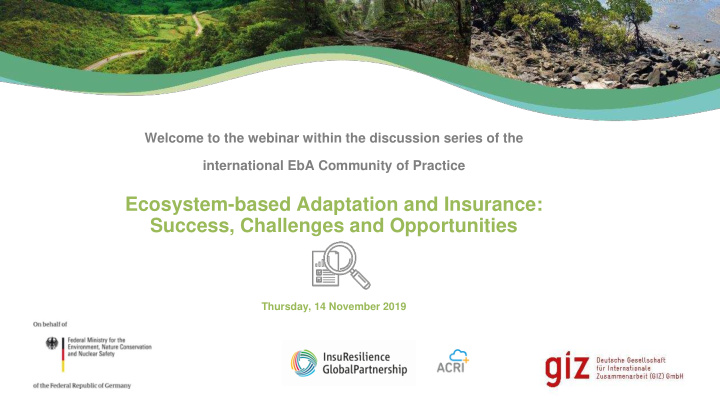



Welcome to the webinar within the discussion series of the international EbA Community of Practice Ecosystem-based Adaptation and Insurance: Success, Challenges and Opportunities Thursday, 14 November 2019
Agenda Introducing the findings of the study on Ecosystem-based Adaptation and Insurance: Success, Challenges and Opportunities Panelists: Michael Beck (University of California Santa Cruz) Kerstin Pfliegner (The Nature Conservancy) Oliver Quast (Social Impact Partners) Daniel Stadtmüller (InsuResilience Secretariat, GIZ) Questions & Answers Facilitation: Andrea Bender (GIZ) This webinar is being recorded and will be published on:
Insurance and Ecosystem-based Adaptation: Successes, Challenges and Opportunities Who we are 14th November 2019 Mike Beck, Oliver Quast, Kerstin Pfliegner 3
The authors A mix of a variety of backgrounds Foto Kerstin Mike Beck Kerstin Pfliegner Oliver Quast Academia NGO Risk Management 4
Definitions What is CRFI and EBA? Climate Risk Financing and Insurance (CRFI) The ability of the insurance industry to support people to adapt to the adverse effects of climate change through • knowledge or • risk transfer or • direct investment Ecosystem Based Adaptation (EbA) The use of biodiversity and ecosystem services as part of an overall adaptation strategy to help people to adapt to the adverse effects of climate change 5
Scientific background 6
Scientific Background Recommended approach: Expected damage function Damages Storm Freq. Estimate Waves Estimate Effects Estimate Estimate Waves Nearshore of Habitats Flooding Offshore Assess Damages 10 yr with Habitat 10 yr w/out Habitat World Bank. 2016. Guidelines for Measuring and Valuing the Coastal Protection Services of Mangroves and Coral Reefs. M.W. Beck & G-M. Lange, editors.
Scientific Background Annual expected benefit from reefs: avoided flood damage in USD M / 20km Beck et al. 2018 . The global flood protection savings provided by coral reefs. Nature Communications 9 :2186
Scientific Background Annual flood reduction benefits from mangroves Losada, Beck et al. 2018. The global value of mangroves for risk reduction. TNC, Berlin.
Scientific Background Value of marshes for property damage reduction during hurricane Sandy Difference in Losses (%) <-60 -60 to - 50 -50 to -25 -25 to -10 -10 to -5 -5 to -0.5 0 -0.5 to 0.5 0.5 to 5 625 Million US$ 5 to 10 15% avg reduction 10 to 25 25 to 50 50 to 100 >100 Narayan, Beck et al. 2017. The value of coastal wetlands for flood damage reduction in the northeastern USA. Scientific Reports 7:9463.
Scientific Background Value of mangroves for property damage reduction during hurricane Irma $1.5 Billion in Avoided Property damages during Irma 25% Annual Reductions Narayan, Thomas, Shepard, K. Nzerem, M. W. Beck et al. 2019. Valuing the Flood Risk Reduction Benefits of Florida’s Mangroves . TNC.
Scientific Background High resolution valuation for US reef benefits Annual Expected Benefits $1.8 Billion Storlazzi, Reguero, Beck et al. 2019. Rigorously valuing the role of U.S. coral reefs in coastal hazard risk reduction. USGS.
Case Studies – methods of analysis and examples 13
Case Studies - Methods Qualitative assessment of successes, challenges and gaps for 11 cases
Case Studies - Methods Criteria-based analysis Climate Risk Identified 12 Monitoring implemented EBA Solution identified 10 8 Monitoring protocol Ecosystem service developed function identified 6 4 Project Implementer Climate Risk rigorously 2 Identified assessed 0 EBA Benefits rigorously EBA Project Implemented assessed EBA Project Designed CRFI Product Developed Buyer Identified Seller Identified
Case Studies US FEMA: Community Rating System (CRS) and cost benefit analysis (CBA) FEMA (2019): National Flood Insurance Program, available online at: https://www.fema.gov/national-flood- insurance-program.
Case Studies FEMA recovery efforts: Benefits / Costs Benefit:Cost Ratio < 0.5 > 0.5 > 0.75 > 1 > 2
Case Studies: Example Mesoamerican Reef Insurance
Findings 19
Findings Selection of observations Lack of understanding EbA solutions are not well understood by the risk industry Funding is available High level interest and key funding are available for solutions that meet multiple objectives General quantification is missing Risk reduction benefits available for only a few ecosystems and are not yet broadly evaluated, wetlands have been considered in industry risk models Involvement of many parties necessary Multi-stakeholder interests make EbA implementation difficult No pilot projects No fully implemented CFRI and EbA demonstration projects as yet (pre-disaster financing and post- disaster financing)
Recommendations 21
Recommendations Educate stakeholders about facts Perception Reality vs.
Recommendations Look at EbA from a holistic perspective Perception Reality Financial benefits - Less costs Grey infrastructure - Additional revenue Biodiversity > vs. Benefits for the Environment Green / blue EbA measures Social Aspects Generation of employment
Recommendations Key recommendations Quantification is needed EbA benefits need to be better quantified and with tools and approaches of industry (e.g. surveys) Modelling tools need to reflect EBA measures The key data (e.g. bathymetry) are in many models however EbA is not fully reflected Build from easier solutions to integrate insurance and EbA Social impact bonds offer great opportunities Focus: Start where financial benefits are greatest To combine private insurance and EbA will require focusing where (private) assets are greatest Cover frequency events through EbA measures Effects are more visible and stakeholders easier to convince Innovative insurers Innovative insurers will invest time and recognize the bis overlaps between concepts
Thank you More in the report, online available here: https://www.adaptationcommunity.net/wp- content/uploads/2019/11/EbA_insurance_publication_2019_web.pdf Mike Beck mwbeck@ucsc.edu Oliver Quast o.quast@socialimpactpartners.eu Kerstin Pfliegner Kerstin.pfliegner@tnc.org
Questions or comments? Please use the chat box
Thank you for your participation! Was this webinar useful for you? The recording of this webinar will be published on: Please give us feedback via the chat box or email to: andrea.bender@giz.de Implemented by:
Recommend
More recommend